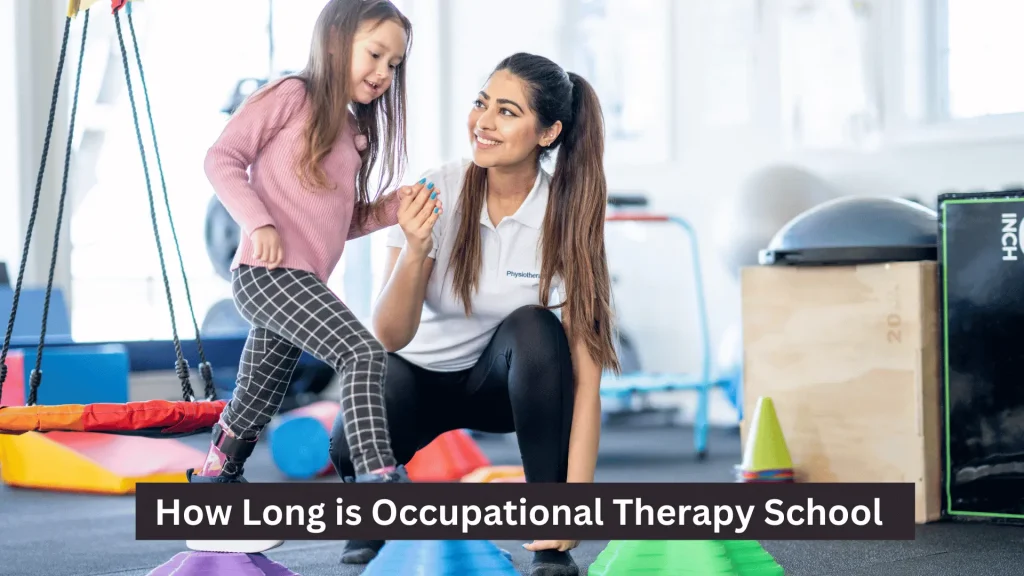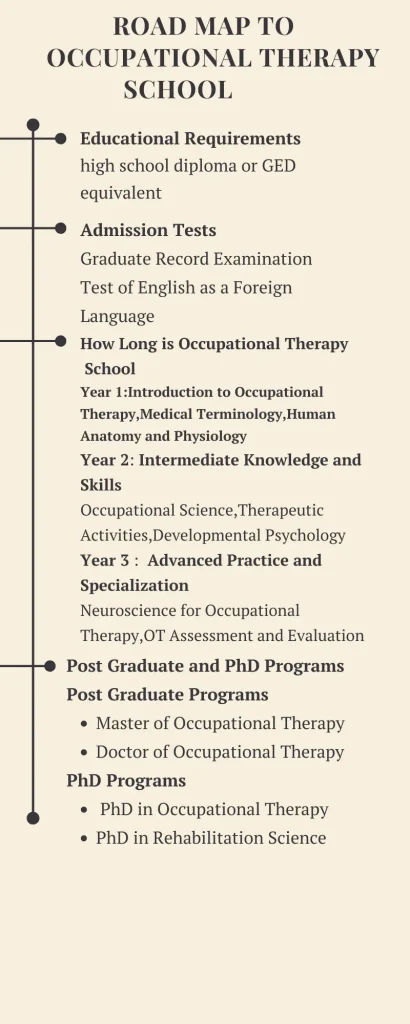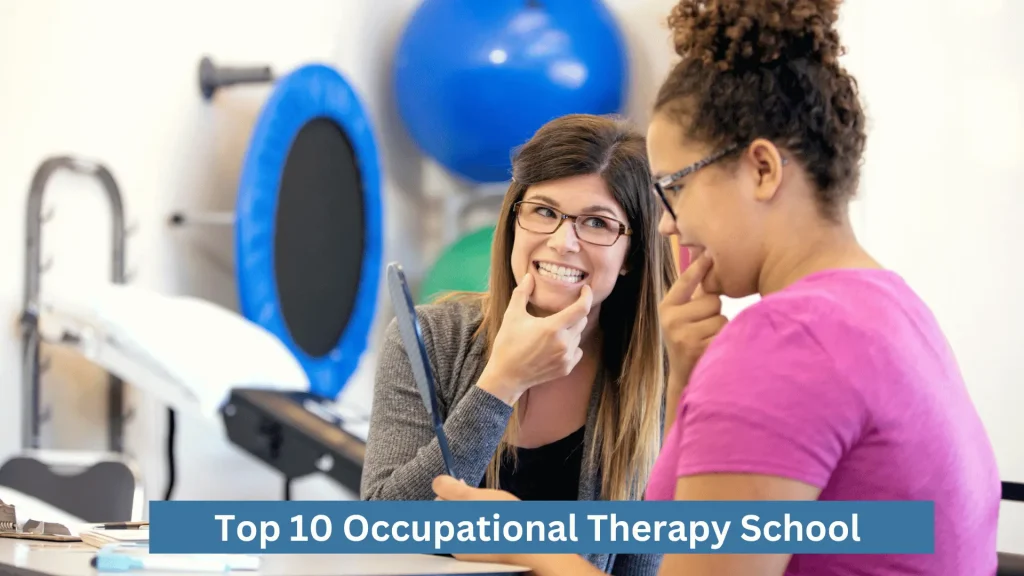How Long is Occupational Therapy School
How Long is Occupational Therapy School? Typically, it takes about 5 to 6 years to complete. This includes earning a bachelor’s degree followed by a master’s degree in occupational therapy. Some programs offer accelerated paths, but the average time remains consistent to ensure comprehensive education and training.
What is Occupational Therapy School
Occupational therapy school is an educational program designed to prepare students for careers as occupational therapists. The curriculum includes coursework in anatomy, physiology, psychology, and therapeutic techniques. Students also complete hands-on clinical training to develop practical skills in helping patients improve their daily living and working skills.
In occupational therapy school, students learn to assess and treat individuals with physical, emotional, or cognitive challenges. The program focuses on developing the ability to create customized intervention plans to enhance patient well-being. Graduates are equipped to work in various settings, including hospitals, clinics, schools, and private practices.

How Long is Occupational Therapy School
Here’s a detailed year-wise explanation of an undergraduate program for Occupational Therapy (OT) School, leading to a Bachelor’s degree in Occupational Therapy or a pre-professional program that prepares students for a Master’s in Occupational Therapy:
Year 1: Foundation and Basics
Courses and Subjects:
- Introduction to Occupational Therapy: Overview of the OT field, history, roles, and career opportunities.
- Medical Terminology: Understanding medical and occupational therapy terminology.
- Human Anatomy and Physiology I: Basic understanding of human anatomy and physiological processes.
- Psychology: Introduction to psychology, focusing on human behavior and mental health.
- Sociology: Understanding societal structures and their impact on health and wellness.
Skills Developed:
- Basic understanding of the OT profession and healthcare terminology.
- Knowledge of human anatomy and physiology.
- Introduction to psychological and sociological principles relevant to OT.
Year 2: Intermediate Knowledge and Skills
Courses and Subjects:
- Human Anatomy and Physiology II: Continuation of the study of human anatomy and physiology.
- Developmental Psychology: Study of human development across the lifespan.
- Kinesiology: Study of human movement and biomechanics.
- Occupational Science: Introduction to the science of occupation and its impact on health.
- Therapeutic Activities: Basics of therapeutic activities and interventions used in OT.
Skills Developed:
- In-depth knowledge of anatomy, physiology, and human development.
- Understanding of human movement and its relevance to OT.
- Introduction to therapeutic activities and their application in OT practice.
Year 3: Advanced Practice and Specialization
Courses and Subjects:
- Neuroscience for Occupational Therapy: Understanding the nervous system and its impact on function and occupation.
- OT Assessment and Evaluation: Methods for assessing and evaluating clients in OT.
- Psychosocial Aspects of Occupational Therapy: Addressing mental health and psychosocial factors in OT practice.
- Occupational Therapy for Physical Disabilities: Techniques and interventions for physical disabilities.
- Clinical Practicum I: Initial hands-on experience in a clinical setting, applying knowledge and skills in real-world scenarios.
Skills Developed:
- Advanced understanding of neuroscience and its application in OT.
- Proficiency in assessment and evaluation techniques.
- Knowledge of psychosocial aspects and interventions for physical disabilities.
- Practical experience through clinical practicum.
Year 4: Professional Practice and Real-World Experience
Courses and Subjects:
- Advanced OT Interventions: Advanced techniques and interventions in various areas of OT practice.
- Research Methods in Occupational Therapy: Introduction to research methods and evidence-based practice in OT.
- Management and Leadership in OT: Principles of management and leadership within the OT profession.
- Clinical Practicum II: Extensive hands-on experience in a clinical setting, focusing on advanced techniques and patient care.
- Capstone Project: Completion of a capstone project or thesis demonstrating mastery of OT concepts and skills.
Skills Developed:
- Mastery of advanced OT interventions and techniques.
- Ability to conduct research and apply evidence-based practices.
- Leadership and management skills in a healthcare setting.
- Extensive real-world experience through clinical practicums.
- Completion of a significant project demonstrating expertise in OT.

How to Enter Occupational Therapy School
Educational Requirements
High School Diploma or Equivalent:
- Completion of high school or equivalent with a strong emphasis on science and math courses.
Undergraduate Degree:
- A bachelor’s degree in a related field such as biology, psychology, or health sciences is often required.
Prerequisite Courses:
- Courses such as anatomy, physiology, psychology, statistics, and human development may be required prior to entry.
Entry Tests
Graduate Record Examination (GRE):
- Many programs require GRE scores as part of the application process.
Test of English as a Foreign Language (TOEFL):
- For non-native English speakers, TOEFL scores may be required to demonstrate proficiency in English.
Application Process
Application Submission:
- Applications are typically submitted through a centralized application service such as OTCAS (Occupational Therapy Centralized Application Service).
Transcripts:
- Official transcripts from all post-secondary institutions attended must be submitted.
Letters of Recommendation:
- Typically, 2-3 letters of recommendation are required, preferably from academic or professional references.
Personal Statement:
- A personal essay or statement of purpose outlining the applicant’s interest in occupational therapy and career goals.
Interviews:
- Some programs may require an interview as part of the selection process.
Financial Aids
Scholarships:
- Many schools offer scholarships based on academic merit, financial need, or specific criteria related to the field of occupational therapy.
Grants:
- Federal and state grants such as the Pell Grant can help reduce tuition costs.
Loans:
- Federal student loans, such as Stafford Loans and PLUS Loans, are available to cover educational expenses.
Work-Study Programs:
- Some schools offer work-study opportunities where students can work part-time to help fund their education.
Assistantships:
- Graduate assistantships may be available, providing tuition remission and a stipend in exchange for teaching or research duties.
Post Graduate and PhD Programs for Occupational Therapy School
Postgraduate Programs in Occupational Therapy
1. Master of Occupational Therapy (MOT)
- Duration: 2-3 years
- Focus: Prepares students for entry-level practice in occupational therapy.
- Admission Requirements: Bachelor’s degree, completion of prerequisite courses, minimum GPA (usually 3.0 or higher), GRE scores (if required), letters of recommendation, and relevant experience.
- Core Courses:
- Foundations of Occupational Therapy
- Human Anatomy and Kinesiology
- Psychosocial Aspects of OT
- Occupational Therapy Interventions
- Clinical Practicum
2. Doctor of Occupational Therapy (OTD)
- Duration: 3-4 years
- Focus: Advanced practice, leadership, research, and specialization in occupational therapy.
- Admission Requirements: Bachelor’s or Master’s degree in Occupational Therapy, minimum GPA, GRE scores (if required), letters of recommendation, relevant experience, and a personal statement.
- Core Courses:
- Advanced OT Interventions
- Leadership and Management in OT
- Evidence-Based Practice
- Specialty Practice Areas (e.g., pediatrics, geriatrics, mental health)
- Capstone Project or Dissertation
PhD Programs in Occupational Therapy
1. PhD in Occupational Therapy
- Duration: 4-6 years
- Focus: Research, academic careers, advanced practice, and development of new OT methodologies.
- Admission Requirements: Master’s degree in Occupational Therapy or related field, minimum GPA, GRE scores, letters of recommendation, research experience, and a research proposal.
- Core Courses:
- Advanced Research Methods
- Statistical Analysis in Health Sciences
- Theories of Occupational Therapy
- Dissertation Research
- Teaching Practicum
2. PhD in Rehabilitation Science
- Duration: 4-6 years
- Focus: Research and development in rehabilitation sciences, including OT, with a broader interdisciplinary approach.
- Admission Requirements: Master’s degree in Occupational Therapy or related field, minimum GPA, GRE scores, letters of recommendation, relevant experience, and a research proposal.
- Core Courses:
- Advanced Topics in Rehabilitation
- Neurorehabilitation
- Biomechanics and Movement Science
- Dissertation Research
- Interdisciplinary Seminars
Top 10 Occupational Therapy Schools

1.University of Southern California (USC):
- Known for its cutting-edge research and comprehensive curriculum.
2.Boston University:
- Offers a strong focus on evidence-based practice and interdisciplinary education.
3.Washington University in St. Louis:
- Recognized for its innovative teaching methods and clinical training.
4.University of Illinois at Chicago:
- Provides extensive clinical experiences and research opportunities.
5.University of Pittsburgh:
- Known for its robust curriculum and research facilities.
6.University of North Carolina at Chapel Hill:
- Offers a balanced approach to theory and practice with strong clinical partnerships.
7.New York University (NYU):
- Emphasizes research, clinical practice, and community engagement.
8.University of Florida:
- Provides a diverse range of clinical experiences and research projects.
9.Colorado State University:
- Known for its focus on innovative practice and research.
10.University of Wisconsin-Madison:
- Offers a comprehensive program with strong emphasis on clinical practice and research.
Factors Affecting the Length of Occupational Therapy School
Program Type:
The type of program (MOT, OTD, PhD) influences the duration, with master’s programs typically taking less time than doctoral programs.
Part-Time vs. Full-Time:
Full-time programs generally take less time to complete compared to part-time programs, which may extend the duration by several years.
Prerequisite Completion:
Students who need to complete prerequisite courses may require additional time before starting the core occupational therapy curriculum.
Clinical Requirements:
The amount of required clinical fieldwork and internships can affect the overall program length, as hands-on experience is critical in occupational therapy education.
Accelerated Programs:
Some schools offer accelerated paths that can shorten the duration of the program by condensing coursework and clinical training.
Dual Degree Programs:
Programs offering dual degrees (e.g., a combined bachelor’s and master’s degree) may have a different timeline compared to standard single-degree programs.
Student’s Background:
Students with prior relevant education or professional experience may be able to complete the program more quickly due to advanced standing or credit transfers.
Institutional Policies:
Each institution’s specific curriculum structure, credit requirements, and academic policies can impact the length of the program.
Final Verdict
Occupational therapy school prepares students for a rewarding career helping individuals improve their daily lives. By understanding the educational requirements, application process, and factors affecting the length of study, prospective students can make informed decisions and plan their educational journey effectively.
FAQs
1.What are the prerequisites for occupational therapy school?
Prerequisites typically include courses in anatomy, physiology, psychology, and statistics.
2.How long does it take to complete an occupational therapy program?
It generally takes 5-6 years, including undergraduate and graduate education.
3.What degrees are available in occupational therapy?
Degrees include a Master of Occupational Therapy (MOT), Doctor of Occupational Therapy (OTD), and PhD in Occupational Therapy.
4.What is the application process for occupational therapy school?
The process includes submitting transcripts, GRE scores, letters of recommendation, a personal statement, and possibly an interview.
5.Are there financial aid options available for occupational therapy students?
Yes, options include scholarships, grants, loans, work-study programs, and assistantships.
